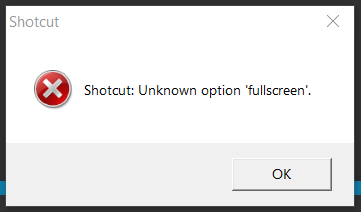

- #QT FULL SCREEN WINDOW HOW TO#
- #QT FULL SCREEN WINDOW UPDATE#
- #QT FULL SCREEN WINDOW WINDOWS 8#
- #QT FULL SCREEN WINDOW WINDOWS#
Placing widgets within a layout manager automatically lays them out according to the defined rules. Qt's layout managers are structured containers which automatically arrange child widgets ensuring that they make good use of the available space. This will ensure that all your widgets will be displayed and resized properly when the form is previewed or used in an application.

After you place all the widgets on your form, you need to place them in a coherent layout.

Qt Designer has a clear and user-friendly interface that allows you to create any kind of GUI by dragging widget onto an empty form. Qt Designer's main interface looks as follows. It allows you to add different kind of widgets to create your GUIs using on-screen forms and a drag-and-drop based interface. With Qt Designer, you can create windows, dialogs, and forms. Qt Designer is the Qt tool for designing and creating graphical user interfaces (GUI) for desktop applications.
#QT FULL SCREEN WINDOW HOW TO#
In this tutorial, you'll learn how to use Qt's layouts with Qt Designer to build complex GUIs for your applications.Īdditionally, we'll create a dialog example using several widgets with a coherent layout to reinforce your knowledge and put everything together into a fully functional dialog just like you would create in a real-world application. To lay out the widget in a form, you can create everything in code, or you can create your layout with Qt Designer. Fortunately, Qt offers a set of layout managers that simplify the process of widget positioning and will allow you to easily create any kind of layout. Just design your UI for some predefined resolution (I use 1600x900 because it fits nicely in windowed mode when debugging) and then set the multiplier in the u.dp() method so that it scales everything up or down according to the actual screen resolution (the Screen QML Type will come in handy).When laying out your PyQt5 GUIs it can be quite a tricky task to place every widget in the right position on your forms. This can be combined with the scalable UI mechanism that I described recently.

You will almost certainly want to add the following line: tResizeMode( QQuickView::SizeRootObjectToView ) It doesn't really matter as long as there is a workaround.Īnother small thing that you must remember about when using QtQuick in fullscreen mode is that the contents of your window should resize to the actual screen resolution.
#QT FULL SCREEN WINDOW WINDOWS#
I'm not sure if this is a bug in Qt or simply a glitch caused by Windows itself it may have something to do with the fact that OpenGL (which is used by QtQuick under the hood) works a bit differently in fullscreen mode, bypassing the windows composition mechanism and rendering directly to the screen, but maybe I'm wrong.
#QT FULL SCREEN WINDOW WINDOWS 8#
I tested this on both Windows XP and Windows 8 and it seems to fix the problem in all situations.
#QT FULL SCREEN WINDOW UPDATE#
Perhaps there is another way to do that, but the most obvious solution that came to my mind was to force an update whenever the window is activated or deactivated: QObject::connect( &view, &QWindow::activeChanged, &view, &QQuickWindow::update ) This optimization works fine in windowed mode, but it causes problem in fullscreen mode. However, if your window only contains static elements, Qt will cleverly avoid repainting it until something changes. But why does it make a difference? An animated item causes the window to be repainted every frame (typically 60 times per second). After some experimentation I observed that adding an animated item (such as a spinning BusyIndicator) solves the problem. It may turn out that when you try to switch back to your QtQuick application, the window won't appear, and the screen will seem frozen.Īpparently I wasn't the only one who observed such problem - I found a few unanswered questions in various Qt forums, so I decided to dig deeper into it. The application will work fine until you press Alt+Tab to switch to another window or Windows+M to minimize all windows. In theory creating a fullscreen application in QtQuick is straightforward - you just have to call the showFullScreen() method of QQuickView instead of show(): QQuickView view


 0 kommentar(er)
0 kommentar(er)
